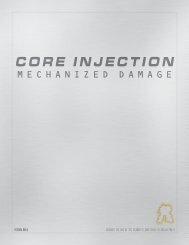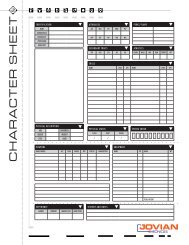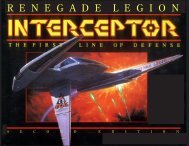renegadelegionneveren dingoffensive - Catsden.net
renegadelegionneveren dingoffensive - Catsden.net
renegadelegionneveren dingoffensive - Catsden.net
Create successful ePaper yourself
Turn your PDF publications into a flip-book with our unique Google optimized e-Paper software.
RVLS<br />
Missile Types<br />
Shields<br />
To begin: the weights of the missiles are changed,<br />
giving more variance. A hardpoint can mount as<br />
many missiles as it has weight, up to a maximum of<br />
4 missiles per HP.<br />
Further (optional): This reverts the missile mechanics<br />
back one notch to 1st edition, in that missiles no<br />
longer automatically move to their target and hit,<br />
instead, they must suffer travel time giving fighters<br />
a chance to outmaneuver or shoot down incoming<br />
missiles.<br />
MISSILE WEIGHT THRUST INITIAL VELOCITY:<br />
DAP 3 18<br />
FIRING CRAFT +1<br />
DFM 1.5 DIRECT<br />
RIS 1.5 14<br />
COST TO TURN 1<br />
SSS 2 16<br />
HEXSIDE:<br />
TGM 2 16<br />
0<br />
Note that HELLs are no longer available as a<br />
dogfighting missile. Instead, the only HELLs<br />
available are torpedos, usable against larger ships<br />
and installations.<br />
The following rules split the to-hit sequence for<br />
direct-fire weapons into two autonomous phases:<br />
checking to see if the weapon strikes the target, and<br />
then a separate roll to see if the weapon actually<br />
pe<strong>net</strong>rates the target’s shield. Separating the two<br />
actions may be more accurate in representing the<br />
weapon’s chances of getting through the flicker<br />
shield. (NOTE: this has already been done in the<br />
2nd edition rules)<br />
Using the statement in the Interceptor Technical<br />
Manual “Under combat conditions, a shield rated at<br />
70 would intercept most incoming attacks 50 percent<br />
of the time”, shield ratings and their associated<br />
percentages were extrapolated.<br />
Under this rule, the to-hit sequence is slightly<br />
modified. First, the firer rolls to hit as normal,<br />
applying all relevant modifiers, EXCEPT for the<br />
shield factor. If this roll is successful, the weapon<br />
has connected, and must then check for shield<br />
pe<strong>net</strong>ration. Each shield rating has a percentage<br />
associated with it, listing the chance the shield<br />
will stop the round. Simply make a percentage roll<br />
against the listed value--if it succeeds, the shield<br />
stopped the impact; if it fails the weapons goes<br />
through the shield, and hits the hull beneath.<br />
SHIELD<br />
RATING<br />
10<br />
20<br />
30<br />
40<br />
50<br />
60<br />
70<br />
80<br />
90<br />
100<br />
110<br />
120<br />
130<br />
140<br />
150<br />
160<br />
170<br />
180<br />
190<br />
200<br />
% CHANCE TO<br />
DEFLECT SHOT<br />
20<br />
28<br />
34<br />
40<br />
44<br />
48<br />
52<br />
57<br />
61<br />
65<br />
68<br />
71<br />
75<br />
79<br />
82<br />
84<br />
87<br />
89<br />
92<br />
94<br />
Damage amount and allocation remains unchanged.<br />
This system is used for direct fire weapons (MDCs,<br />
EPCs, NPCs, Lasers, TPPs, etc) only.<br />
There are no changes to the base rules for missiles or<br />
any other weapon.<br />
XII





